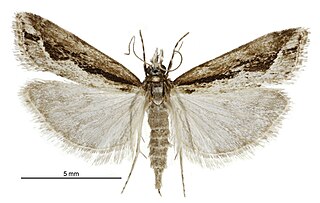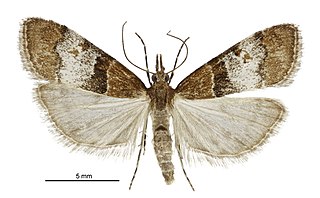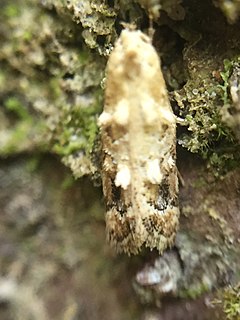
Eudonia steropaea is a species of moth of the family Crambidae. It was named by Edward Meyrick in 1884. Meyrick gave a detailed description of this species in 1885. It is endemic to New Zealand.

Gadira petraula is a species of moth in the family Crambidae. This species is endemic to New Zealand and is only found in mid Canterbury. G. petraula inhabits coastal, montane and low alpine rock sites. The larvae live in rock crevices in a silk shelter from which they emerge to feed. Their host plants are moss or lichens. The adult female is flightless and the male is on the wing in March. This species is classified as "At Risk, Naturally Uncommon" by the Department of Conservation. The 2010 and 2011 Christchurch earthquakes destroyed much of this species preferred habitat. Rock climbers cleaning rocks of the larval host plants are also a threat to the survival of this species.

Pyrausta comastis is a moth in the family Crambidae. This species is endemic to New Zealand. It has been classified as "nationally vulnerable" by the Department of Conservation.

Antiscopa acompa is a moth in the family Crambidae. It was first described by Edward Meyrick in 1884. It is endemic to New Zealand and is found both the North and South Islands. The species inhabits native forest and adult moths are attracted to light.

Eudonia critica is a moth in the family Crambidae. It was named by Edward Meyrick in 1884. It is endemic to New Zealand.
Eudonia eremitis is a moth in the family Crambidae. It was described by Edward Meyrick in 1885. It is found in Australia, where it has been recorded from South Australia.
Eudonia homala is a moth in the family Crambidae. It was described by Edward Meyrick in 1885. It is found in Australia, where it has been recorded from South Australia.

Eudonia legnota is a moth in the family Crambidae. This species was named by Edward Meyrick in 1884. It is endemic to New Zealand.

Eudonia microphthalma is a moth in the family Crambidae. It was described by Edward Meyrick in 1884. It is endemic to New Zealand.
Eudonia perierga is a moth in the family Crambidae. It was described by Edward Meyrick in 1885. It is found in Australia, where it has been recorded from Tasmania.

Eudonia philetaera is a moth in the family Crambidae. It was named by Edward Meyrick in 1884. Meyrick gave a description of the adult moth in 1885. It is endemic to New Zealand.
Scoparia eumeles is a moth in the family Crambidae. It was described by Edward Meyrick in 1885. It is found in Australia, where it has been recorded from New South Wales.
Scoparia eutacta is a moth in the family Crambidae. It was described by Alfred Jefferis Turner in 1931. It is found in Australia, where it has been recorded from Queensland.
Scoparia gomphota is a moth in the family Crambidae. It was described by Edward Meyrick in 1885. It is found in Australia, where it has been recorded from Tasmania.
Scoparia tritocirrha is a moth in the family Crambidae. It was described by Alfred Jefferis Turner in 1918. It is found in Australia, where it has been recorded from Norfolk Island.
Canuza acmias is a moth in the family Crambidae. It was described by Edward Meyrick in 1897. It is found in Australia, where it has been recorded from New South Wales.
Ardozyga stratifera, the striped ardozyga moth, is a species of moth in the family Gelechiidae. It was described by Edward Meyrick in 1904. It is found in Australia, where it has been recorded from Queensland, New South Wales, Victoria, Tasmania, South Australia and Western Australia.
Scythris niphozela is a species of moth in the family Scythrididae. It is endemic to New Zealand. It is classified as "At Risk, Naturally Uncommon" by the Department of Conservation.

Trachypepla aspidephora is a species of moth in the family Oecophoridae. It is endemic to New Zealand and has been observed in the North and South Islands. Adults are on the wing from November to March and are attracted to light. The moths can be found resting on tree trunks where their colouration imitates lichens.

Trachypepla galaxias is a moth of the family Oecophoridae first described by Edward Meyrick in 1883. It is endemic to New Zealand and can be found throughout the country. This species inhabits native forest. The life history of this species is currently unknown. Adults are on the wing from October to February, are nocturnal and are attracted to light.









